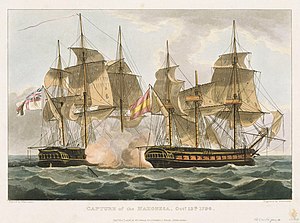Action of 13 October 1796
| Action of 13 October 1796 | |||||||
|---|---|---|---|---|---|---|---|
| Part of the French Revolutionary Wars | |||||||
 Print by Thomas Whitcombe depicting HMS Terpsichore capturing the Mahonesa on 13 October 1796 | |||||||
| |||||||
| Belligerents | |||||||
|
|
| ||||||
| Commanders and leaders | |||||||
|
Richard Bowen |
| ||||||
| Strength | |||||||
| 1 frigate | 1 frigate | ||||||
| Casualties and losses | |||||||
| 4 wounded |
30 killed 30 wounded 1 frigate captured 250 captured | ||||||
The action of 13 October 1796 was a minor naval engagement of the
Spain had been an ally of Britain in the first years of the
Off Cartagena Bowen commanded the small frigate Terpsichore, which had been shadowing a large Spanish fleet which had left Cádiz a few days earlier. As he returned to
Background
In early 1793
As the war progressed the Spanish suffered a series of defeats on land in the
British forces in the Mediterranean were commanded by Vice-Admiral
Action
On 11 October, Lángara reached the Spanish Mediterranean
Bowen's ship was undermanned, having landed 30 men for medical treatment at Gibraltar and with another 30 on board unfit for action,
As the action continued, Ayalde found that his men were slipping away from their guns and that fewer and fewer could be persuaded to return. Recognising that defeat was now inevitable, he ordered sails set and attempted to retreat to Cartagena.
Combatant summary
In this table, "Guns" refers to all cannon carried by the ship, including the maindeck guns which were taken into consideration when calculating its rate, as well as any carronades carried aboard.[19] Broadside weight records the combined weight of shot which could be fired in a single simultaneous discharge of an entire broadside.
| Ship | Commander | Navy | Guns | Tons | Broadside weight |
Complement | Casualties | ||
|---|---|---|---|---|---|---|---|---|---|
| Killed | Wounded | Total | |||||||
| HMS Terpsichore | Captain Richard Bowen
|
32 | 682bm | 276 pounds (125 kg) | 182 | 0 | 4 | 4 | |
| Mahonesa | Captain Tomás de Ayalde | 34 | 921bm | 180 pounds (82 kg) | 275 | 30 | 30 | 60 | |
| Source: Clowes, p. 504 | |||||||||
Aftermath
Bowen effected repairs on board Terpsichore and his
With Mann's desertion and the Spanish declaration of war, Jervis found his fleet isolated and outnumbered. Acting on orders from the
Notes
- London Gazette reported how, on 24 May 1797, Mahonesa and HMS Romulus captured a 20-gun Spanish Corvette in a ruse de guerre. Approaching under false colours, Nuestra Senora del Rosario was taken without a shot being fired.[21] In addition, Winfield, in the second volume of his British Warships in the Age of Sail series, claims that Mahonesa served until August 1798.[22]
Sources
- ^ a b Ireland, p.144
- ^ Mostert, p.97
- ^ Mostert, p. 113
- ^ Clowes, p.212
- ^ a b Gardiner, p.89
- ^ Gardiner, p.116
- ^ James, p.273
- ^ Clowes, p.277
- ^ Mostert, p.182
- ^ a b Mostert, p.184
- ^ Clowes, p.286
- ^ Mostert, p.185
- ^ a b Campbell, p.79
- ^ James, p.311
- ^ James, p.357
- ^ a b c d e James, p.358
- ^ a b c d e f "No. 13954". The London Gazette. 22 November 1796. p. 1133.
- ^ Clowes, p.504
- ^ James, Vol. 1, p. 32
- ^ a b James, p.359
- ^ "No. 14023". The London Gazette. 27 June 1797. p. 615.
- ISBN 978-1-84415-700-6.
- ^ Campbell, p.82
- ^ Mostert, p.198
- ^ Clowes, p. 320
- ^ Campbell, p.83
- ^ James, p.361
- ^ Campbell, p.87
- ^ Mostert, p.220
- ^ Campbell, p.89
- ^ "No. 20939". The London Gazette. 26 January 1849. pp. 236–245.
References
- Campbell, John (1818). Naval History of Great Britain: Including the History and Lives of the British Admirals. Vol. 7. London: Baldwyn and Co.
- ISBN 1-86176-012-4.
- Gardiner, Robert, ed. (2001) [1996]. Fleet Battle and Blockade. London: Caxton Editions. ISBN 1-84067-363-X.
- ISBN 0-3043-6726-5.
- ISBN 0-85177-905-0.
- Mostert, Noel (2007). The Line upon a Wind: The Greatest War Fought at Sea Under Sail 1793 – 1815. Vintage Books. ISBN 9-78071-260-9272.
